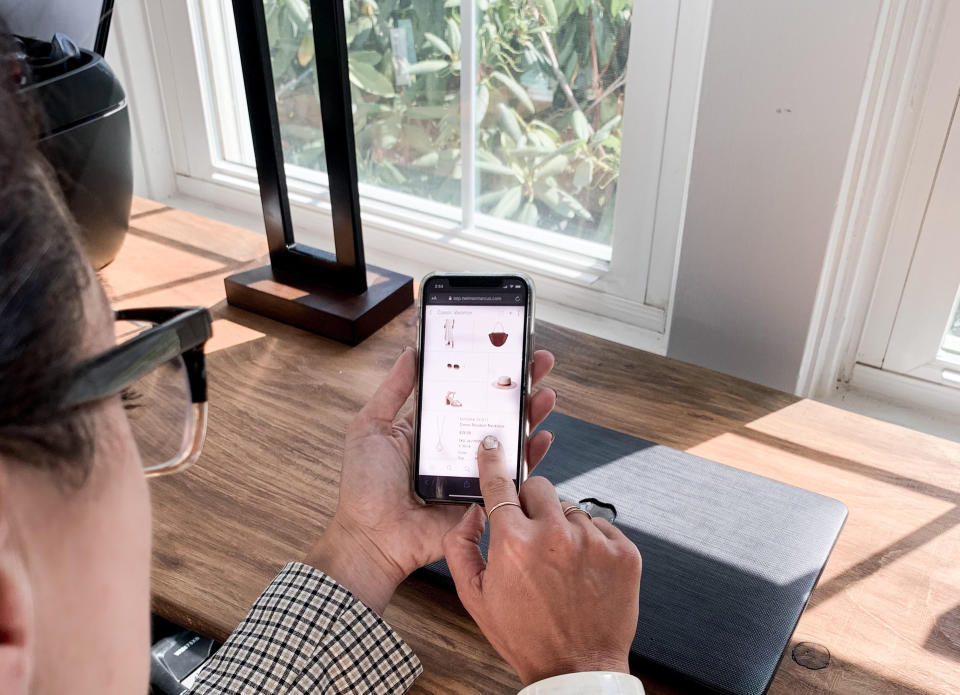New Breed of Commerce Takes Cues From Old

Every retail story this year is a variation on the same theme: Thanks to the coronavirus, online has blown up, while brick-and-mortar’s fate hangs in the balance. Drill down a little more, however, and another important picture forms.
Consider that the coronavirus hasn’t actually killed the in-store experience, but rather, pushed it beyond physical boundaries.
More from WWD
As some stores raced to set up online shops, others have been looking beyond static e-commerce sites, product pages and Amazon listings. Technology is driving a newer breed of e-commerce that offers a bridge between old and new retail, with remote services that keeps the spirit of brick-and-mortar shopping alive.
Neiman Marcus turned to tech to help redefine itself during a pandemic that tanked sales and brought bankruptcy. The department store has been promoting the online services — such as stylist match, remote assistance and virtual demos — that 4,900 associates, stylists and managers across Neiman Marcus and Bergdorf Goodman use to bring the feel and flavor of its personalized in-store service online.
Part of this magic comes from Stylyze, which developed a remote clienteling app used by the store. The platform uses a combination of human and artificial intelligence, according to Stylyze cofounder and chief executive officer Kristen Miller. The company built product-typing taxonomies to identify and describe items, while human stylists taught the system how to create looks or what items go together. Now the technology helps consumer-facing stylists serve their clientele.
“Even as stores reopen, what we’re going to find is more and more of that trend toward offering a white-glove experience, but doing it remotely or doing it virtually,” explained Miller. “And so this is really the leading edge and the start of being able to satisfy that need for the industry, where clients aren’t having to sacrifice a really great experience.
“They’re able to get it, but the stylist needs the technology to be able to do that and be able to have their virtual eyes, to say, ‘I’m trying to show a piece to a client, but it’s out of stock. Show me similar ones or some pre-generated looks for ath-leisure, that I can then build on and edit and customize,’ which is really what this does,” she added.
Customers can engage with the looks or mood boards that stylists work on, as if they were huddled together in the same room, going over outfits. Over three months, the technology brought in sales topping $60 million for Neiman’s.
Tech trends that invoke the feel of in-person retail aren’t limited to department stores, either. Athletic footwear brand Hoka partnered with Snapchat in August on an augmented reality Lens that virtually re-creates a physical pop-up shop. Think of it as a riff on WebVR stores, which some brands use to mimic their physical spaces in browser-based virtual reality. Meanwhile, social commerce has embraced features like virtual try-ons in Snapchat, Instagram and other tools from beauty platforms from L’Oréal’s Modiface to Perfect Corp. and its YouCamm apps, which have become the new beauty counters.
Such mixed-reality technology isn’t new, but it has gotten new life as an accessible version of VR over mobile or desktop that requires no goofy goggles. In other words, it’s well-suited for the fashion and beauty sectors.
These particular slices of e-commerce technology got a boost from the pandemic, but they look like they’re here to stay after the health crisis subsides. According to CB Insights, investment dollars are surging into these areas, which means more development for the foreseeable future.
CB Insights’ latest “State of Retail Tech H1’20” report explained that e-commerce investments in the first quarter declined, but as shoppers stormed the Internet, the following period saw a jump of 6 percent, quarter over quarter, to $3.1 billion.
The report singled out social commerce start-ups, resale platforms, virtual shopping tools and on-demand services as key focal areas for investors. And although the number of investments fell, overall dollars grew — which points to each deal being of greater value.
“The things that I have been watching and seeing take off is really anything that’s going to drive engagement and personalized service, particularly digitally,” said Laura Kennedy, senior lead analyst at CB Insights. “We’re seeing a lot of that in categories like apparel, fashion, luxury and beauty that previously would have required a lot of in-store and in-person contact.”

 Yahoo Finance
Yahoo Finance